Even though we won’t see him in Barcelona colours until at least the summer, Francisco Trincao is already an official Blaugrana player. The young Portuguese forward will, however, stay at Braga for the time being, back in his home country, on loan to ply his trade a bit more and mature so he can slot right into the Catalans’ lineup in La Liga once the time comes.
But how exactly can Barcelona use his talents and skill set to their advantage and is he even the right profile for their incredibly valuable and yet unbalanced squad? This tactical analysis will look at how Trincão can fit Barcelona’s tactics and use analysis to determine whether he was a shrewd signing for the Catalans.
Player overview
Generally speaking, Trincão is a highly versatile forward who is most effective when given a free licence on either of the flanks. He is, however, most comfortable as the out-and-out no.7 over on the right-wing where he can either be a width provider or cut inside to shoot with his preferred left foot.
Speaking of his player profile, the 20-year-old lad resembles a young Lionel Messi, albeit his feats are still far from being comparable to the Argentine alien. Still, his dribbling skills, the 1v1 danger he possesses when isolated with the defenders and his creativity and ingenuity in tight spaces do make him fairly similar to Barcelona’s superstar.
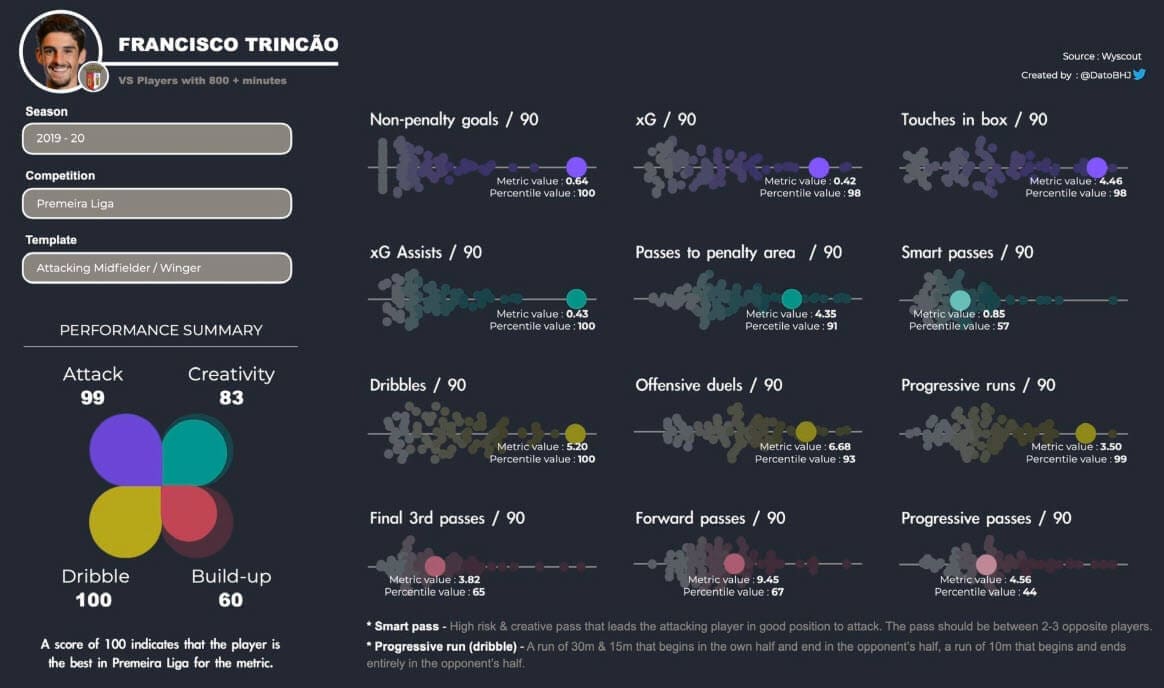
Looking at the graph above, we can see some of the areas in which the young forward excels. His final product in terms of goals and contributing to them is in the high percentile ranking. The same can be said for his progressive runs, touches in the box and dribbles.
Where he currently lacks, however, is passing and this will have to be improved upon if he’s to slot into Barcelona and their tactics. But looking at his attributes, he could be used as the missing wide man for the Catalans and somewhere further down the road, if he develops properly and continues growing, he may even be used in that Messi role no one has been able to fill in years.
This tactical analysis scout report will now delve deeper into the possible ways Barcelona can incorporate the young Trincão into their tactics.
The missing piece
As things currently stand, Barcelona are missing a true winger to occupy their flanks and provide them with the necessary width and pace. With Ousmane Dembélé out injured and his future still highly uncertain and with Carles Perez sold, the Catalans were mostly without real wingers and had to resort to plugging the holes with players who don’t necessarily fit the profile.
This is a problem that goes as far back as the departure of Neymar Junior to Paris Saint-Germain and shockingly enough, it hasn’t been solved since. Trincão, however, could be the answer to this issue.
Even though he is far from a traditional winger himself, he offers the pace, danger in 1v1 situations and most importantly, consistent runs in behind the defence. Before we take a look at the possible responsibilities he could have at Barcelona in this role, let’s quickly compare him to other players who have since had the opportunity to be the Catalans’ wide men.
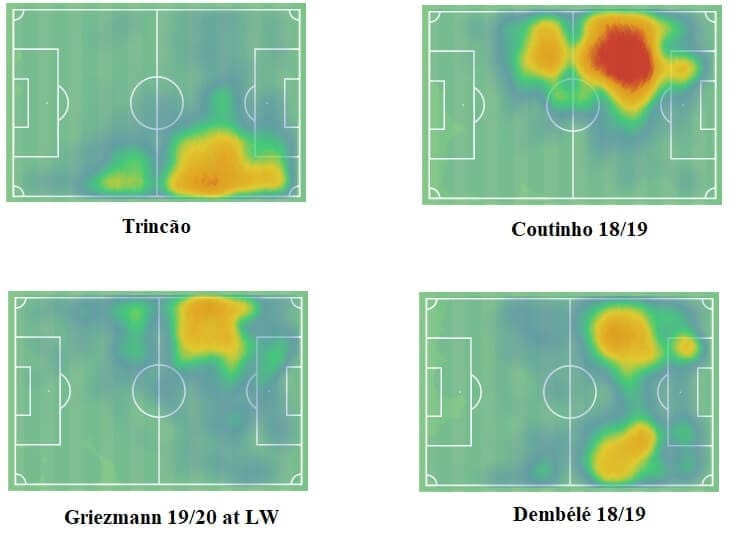
By looking at Trincão’s heatmap and comparing it to that of Philippe Coutinho, Antoine Griezmann and Dembélé respectively, we can see that while he does share their tendency to slot into his half-space, the young forward also regularly occupies the flanks and makes runs well into the opposition’s final third.
This is a stark difference between him and all of the players mentioned bar Dembélé, who seems to be the highest-positioned among the other three. But even the Frenchman seems to prefer being positioned more centrally as opposed to Trincão’s tendency to stay out wide.
We can quickly compare him to some other forwards in Europe to see who matches his profile the most. Notice in the graphic below that he could be compared to the likes of Serge Gnabry or even Timo Werner due to his exploitation of space and lethality in the box.
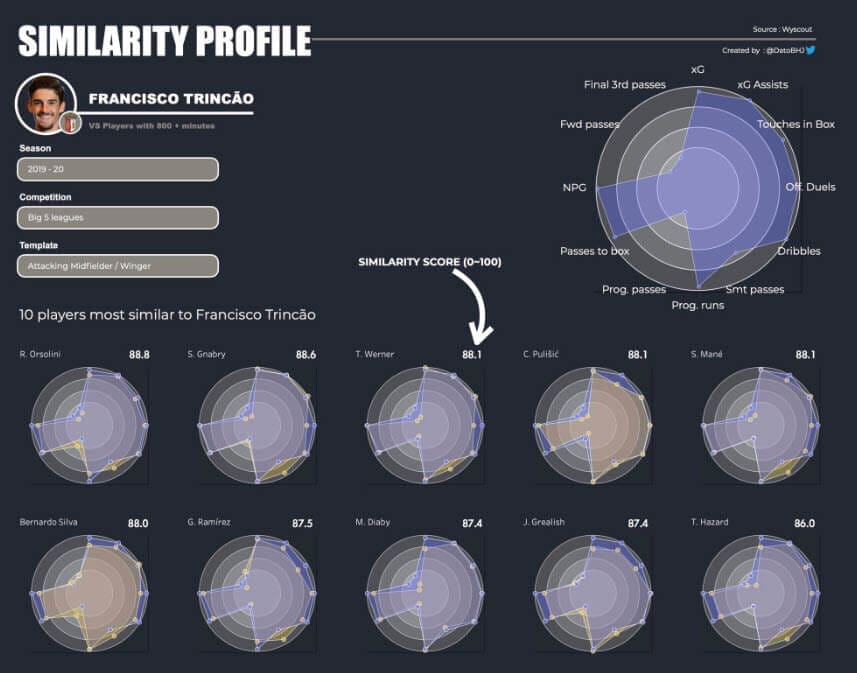
This could be crucial in helping Barcelona maintain the width and stretch the opposition as opposed to consistently trying to penetrate them centrally when facing low and compact blocks.
They still have the necessary tools to create space even when teams turtle up against them but exploiting it with willing runners, pace and penetration is still a big problem. Trincão could solve that. At Braga, he often keeps his wide and high positioning and will use his acceleration to charge behind the defensive line, as we can see from the example below.
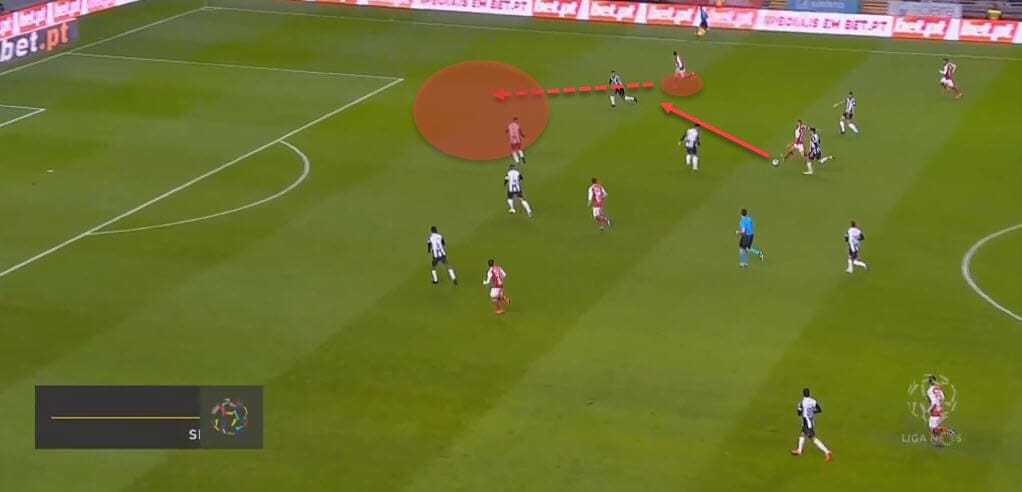
Braga are on the attack and Trincão is ramping up in speed to sprint past the defender and use the space deeper towards the opposition’s goal. Barcelona will often have Messi on the ball in the exact same position as Trincão’s teammate but no one to exploit the Argentine’s incredible vision.
But just as with every other role, being a Barcelona winger also means you have to be versatile enough and adapt to the system. Sometimes, that will mean keeping the width and stretching the backline but at other times, it will mean knowing when to cut inside and play off of your teammates, namely your full-backs and your striker.
Barcelona’s centre-forwards are usually extremely involved in the build-up and will occasionally drop deeper to link up with the midfield. This movement usually does two things. Firstly, it helps progress the ball and secondly, it pulls the defenders out of their shape and creates pockets of space for other runners to exploit.
This is where Trincão comes into play and we’ve seen him involved in such tactics at Braga as well. Note below how the Portuguese team does the very same sequence by dropping their forward to create space behind the defensive line. Trincão immediately recognises the opportunity and runs into the area.
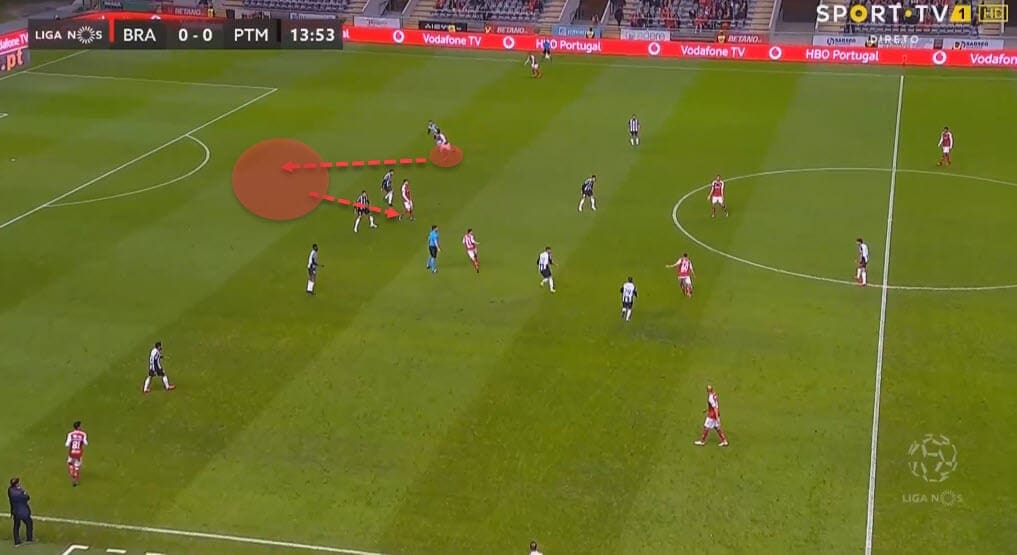
Although there is no stat to adequately measure runs in-behind the defensive line, we can conclude he is indeed a willing runner by his heatmap, which was analysed earlier in this tactical analysis scout report, and the fact that he averaged 3.5 progressive runs and 4.47 touches in the box in 2019/20.
When we compare him to the rest of the players within the Portuguese Primeira, he is in the top 10% in both categories, which can be seen in our initial graph at the beginning of this piece.
Finally, a Barcelona winger will have to be able to work closely with his full-back to successfully create overloads on the flanks and cooperate their movement to inflict the most damage possible. Regardless of which wing he gets to play in, Trincão will have to be in sync with his respective full-back and coordinate overlaps and underlaps when attacking.
Barcelona rely heavily on their full-backs to provide the width and while that may change with the introduction of a true winger, it’s also quite possible that they will aim to make full use of their full-backs regardless. Luckily, Trincão is also used to playing in the half-spaces, often tucking in and advancing through central areas, allowing the full-back to overlap.
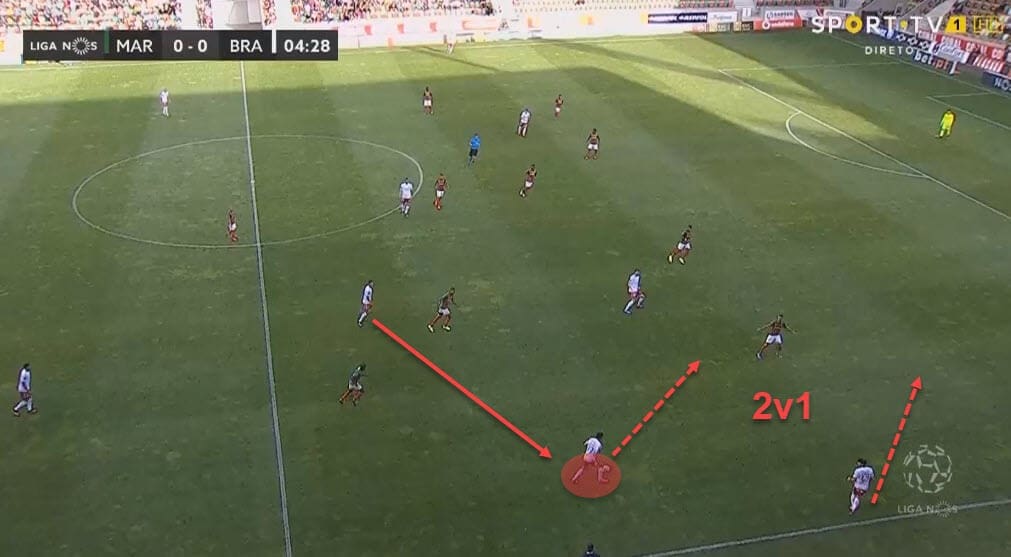
Notice in the example above how he does drop deeper and moves more centrally to accommodate the full-back in his overlap and then progresses the ball further up the pitch to create an overload on the wide defender.
This highlights the compatibility with Barcelona’s wide men but also tells us that he has the tools to become a playmaker from the deep, something which the Catalans only have Messi for.
Let’s explore that a bit further.
The Messi role
Even though he is not ready for such a responsibility just now, Trincão seems well equipped to perform the ‘Messi role’. The Argentine is only a winger on paper and he can mostly be seen in central zones and deeper areas despite starting wide.
A similar thing can be said for Trincão as well. Even though he tends to stay high and wide, he prefers to cut onto his left foot, go through the half-space and use his extraordinary technique and dribbling to beat the opposition’s block. We can see a fairly usual sequence in Braga’s attack that involves the young gem below.
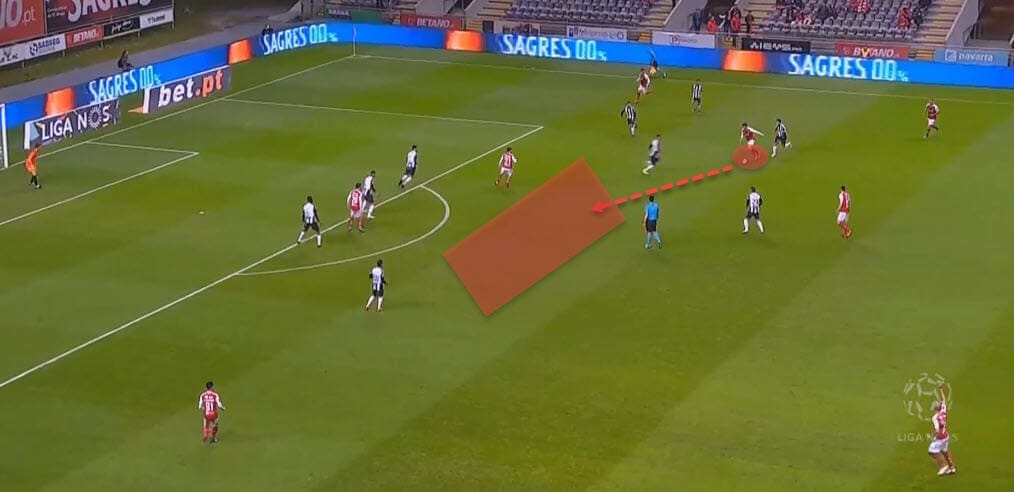
Trincão receives the ball in the right half-space and proceeds to cut inside and towards the zone 14, trying to beat the opposition defender in a 1v1 duel in the progress. And seeing how he wins 55% of the dribbles he attempts, we can confidently say this is a big strength of his.
We’ve already seen that he is an excellent ball progressor with 3.5 progressive runs on average in 2019/20 and with eight goals, seven assists and 38 shot assists across a total of just 1750 minutes, his contribution in the final third is already palpable.
But there’s much more to the ‘Messi role’ than being an exceptional individual on the pitch. The part of Messi’s magic is in bringing others into play and this could be an area in which Trincão still falls short. Whether it’s due to Braga’s system or simply the fact they don’t face nearly as many low-blocks as Barcelona but Trincão still doesn’t drop deep to collect the ball and set up play nearly as much.
Part of the problem could lie in his passing abilities, which are quite low for a future Barcelona player. He averages 75.9% passing success rate, 30% accuracy in through passes and 50% in long balls in 2019/20. These numbers are not bad per se for a 20-year-old but also nowhere near where they should be for a deep playmaker.
But despite all of that being said, we’ve seen shades of potential for the young forward in that role as well throughout 2019/20. When the situation on the pitch required such actions, he would drop deeper to link-up with his defenders and quickly progress the ball onto the flanks. You can see an example of that below as Trincão is used as an outlet to get the ball out wide and into the unmarked full-back that’s not visible in the shot.
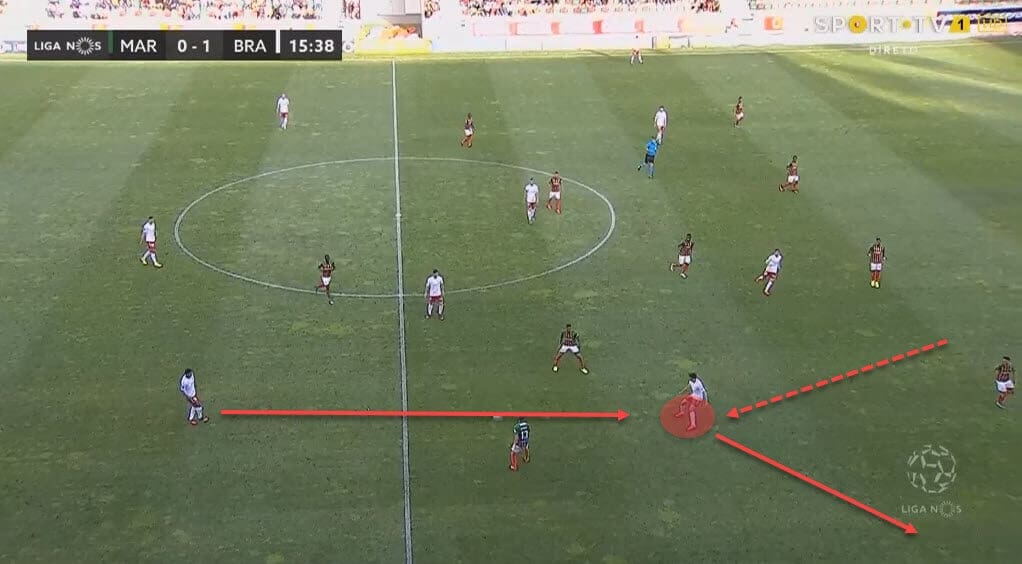
This, coupled with his ability to receive the ball in deeper areas and then run with it into the final third, does indicate he has the right tools to succeed in this role at Barcelona as well. With that being said, he will have to improve on his passing immensely.
Still, we have seen instances where he would occupy a deeper zone and then switch play and send passes over the top and into space, proving that he has it in his locker to eventually transition into that role. Note, for example, how that looked like on the pitch in the following example.
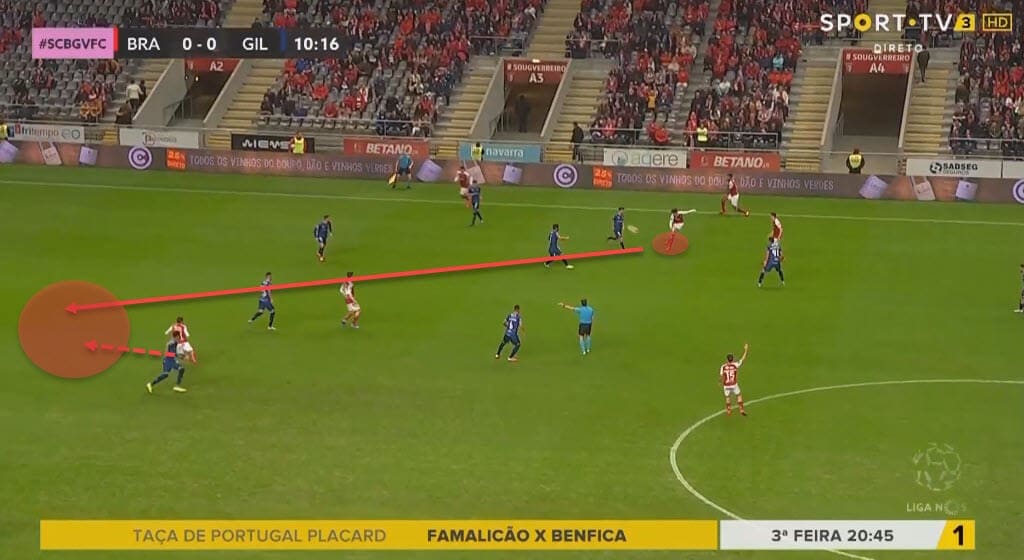
It has to be noted, however, that despite him deploying 1.54 long passes and 1.03 through passes on average in 2019/20, this is still not a prominent trait nor a weapon that’s utilised regularly and to great effect.
As of right now, he has the foundations to perform this role but is not there just yet.
Possible variations in Barcelona’s lineup
As a final segment of this tactical analysis scout report, we’ll take a look at the possible variations in Barcelona’s system when Trincão is included in the equation. There are three options we’re going to highlight for now.
The first one would be with the young Portuguese forward slotting next to Lionel Messi and Barcelona’s no.9 in the team. In that scenario, Messi would be deployed into Trincão’s preferred right-wing so that would mean the youngster would have to shift to the opposite side. But even so, he’s well-equipped to handle that as he’s good with both feet and versatile enough to play from the left and then stay wide, focusing on his stronger left foot, instead of cutting inside to the right.
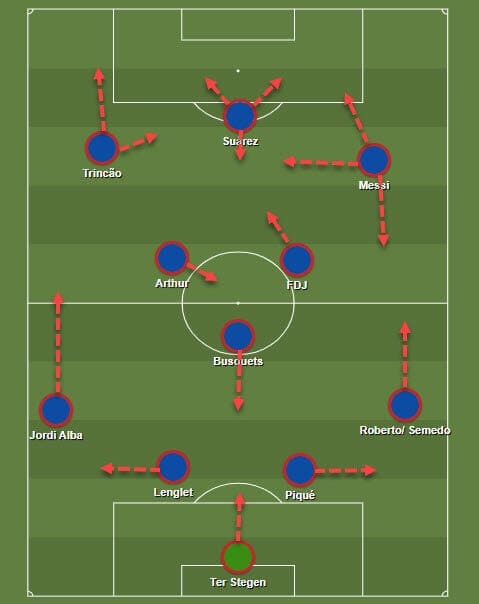
Since Jordi Alba likes to have a big influence in the attacking phase, Trincão would have no trouble slotting into his respective half-space to accommodate the surging full-back who would then overlap. We’ve seen Trincão’s relationship with his full-back at Braga and a similar thing will most likely have to happen at Barcelona.
Of course, with him on the wing, the Catalans would have a willing runner who could work off of the no.9, whether that’s Luis Suárez or anyone else, and combine with the full-back to make the most out of their attacks.
But even though this could also work, Trincão would be far more comfortable on the other side of the pitch, on the right-wing. There, he can cut inside when an opportunity arises and operate in a more familiar area overall, which is important for such a young and inexperienced player. We have two different outcomes in such a scenario.
If Messi is on the pitch and the coach wants Trincão on the right-wing to get the best out of him, it would be ideal to put the Argentine in the false nine role and then the youngster at no.7. With Messi operating in and around zone 14, Trincão would mostly be used as a width-provider with a similar role to the one we pointed out for the left-wing position.
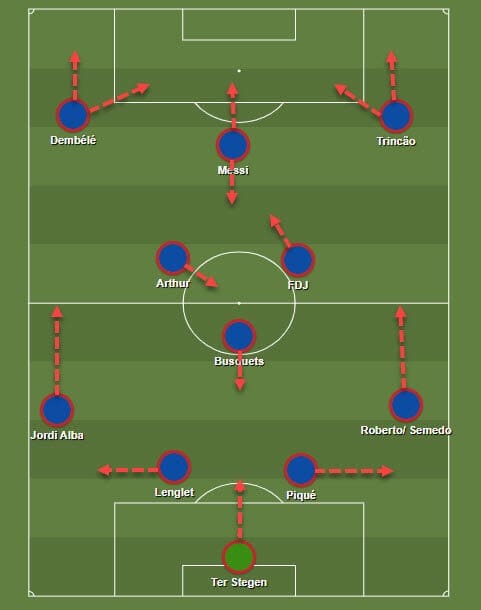
With another winger on the opposite side, ideally Dembélé, it would ensure Barcelona have a hardworking winger on either side at the same time. This would give them the needed personnel in the wider areas who would utilise Messi’s vision and would offer running outlets behind the opposition’s backs.
Not only that but Trincão’s presence would occupy defenders and create space for Messi to do his thing with more freedom. Think of Pedro and David Villa back in the day who would often ‘be sacrificed’ for the better of the team and to accommodate Messi’s movement and role.
Finally, we do have to mention that Trincão does have the potential to slot directly into Messi’s shoes somewhere further down the line once the Argentine calls it a day or drops deeper into the midfield. He doesn’t seem to have such a high ceiling, at least as of right now, and there are still some aspects he has to significantly improve, as we have highlighted in a previous section of this tactical analysis scout report, but the possibility is certainly there.
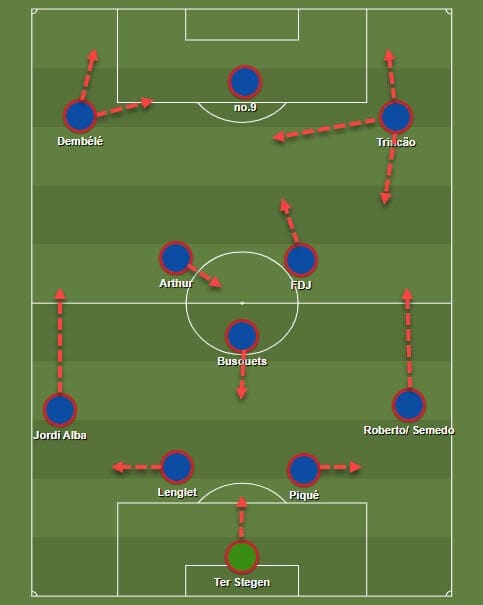
He already has that tendency to vacant the right-wing when necessary and advance through the half-space towards the central areas. Occasionally, we’ve seen him drop deep to provide an outlet for his defenders/ midfielders or to carry the ball towards the final third himself.
Even though his passing and vision need more work, the groundwork is already there for him to start constructing attacks as a deeper playmaker and eventually transition to a no.10 or even a false nine role. His versatility means that he’s not limited to staying just on the right side of the pitch and close control and technical prowess also give him an edge in that free role in and around the box, just like Messi does right now.
On paper, he has all the tools to succeed but it all depends on the way he develops and how he adapts to Barcelona’s tactics.
Final remarks
Many have fallen into the trap of delivering various verdicts on young talents far too soon and either condemning or glorifying them unnecessarily. We’ll try to swerve away from such conclusions but Trincão does possess most of the tools that he’ll need to succeed at Barcelona.
He is, however, still very young and far from a finished product, which is visible in some of his glaring weaknesses. But that is not too concerning just yet and if the Catalans play their cards right, the Portuguese star in making could become one of the players to carry Barcelona in the future.
Whether that means doing his best Messi impression or something completely different remains to be seen.

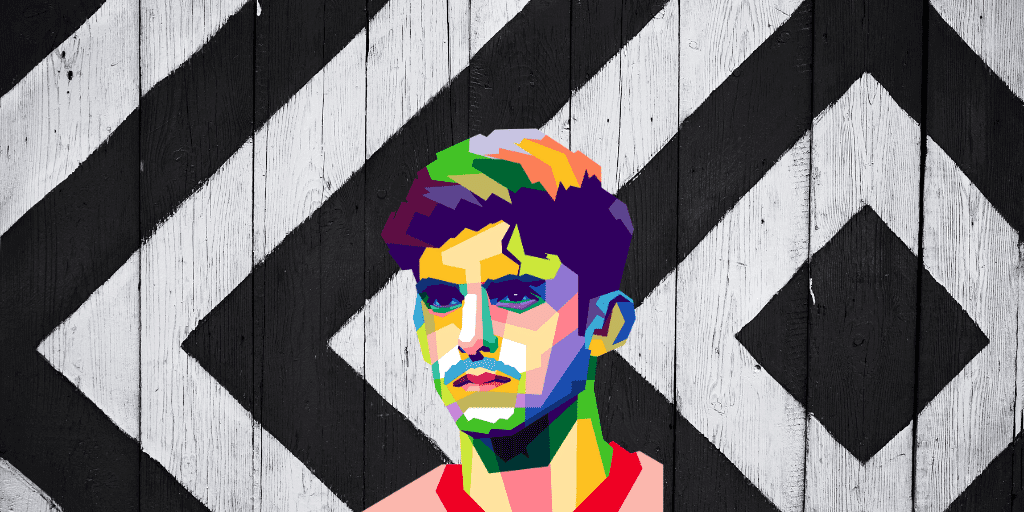



Comments